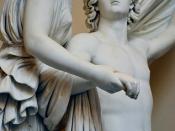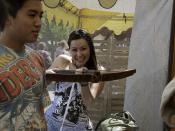The sculptures of the Pantheon were often seen as the best examples of the 'high
classical style' Greek art. They consisted of one long frieze, several square panels and
two huge triangular compositions which were taken from the main temple of the
goddess Athene in Athens built c550 BCE. However the Pantheon marbles did not
arrive in the West until the first half of the nineteenth Century and although ancient
sculpture was central to the canon during the Renaissance, most examples were either
Roman copies of Greek works or Hellenistic.
Art theorist Giovanni Pietro Bellori (1615-96) made a significant contribution to the
development of the canon by looking closely at ancient sculpture and using it to apply
to modern standards of painting. His main point from the extracts of his book Lives of
the Modern Painters, Sculptors & Architects 1672 is that perfect beauty does not
exist in nature, therefore the realm of Ideas should be used to overcome natural
deformities and disproportion.
Bellori, sites Cicero as a perfect exemplar, as when he
calved the sculptures of Jupiter and Minerva he "did not contemplate any object from
which to take likeness, but considered in his mind a form full of beauty on which he
concentrated..." (Fernie, p64) Bellori likened the Ideal as a reflection of the first
perfect creation, thus giving it Godly significance.
Bellori's arguments were based on the ideas of a number writers from antiquity as well
as Vasari's The Lives of Artists (1568). He was lead to the concluded that artists
should seek out the works that best showed the Ideal beauty and strive to attain these
qualities in their own works. Thus he defended the art of Raphael and others when
critics said they were merely "imitators of antiquity" (Ferni, p61).
Bellori's book had a significant...


